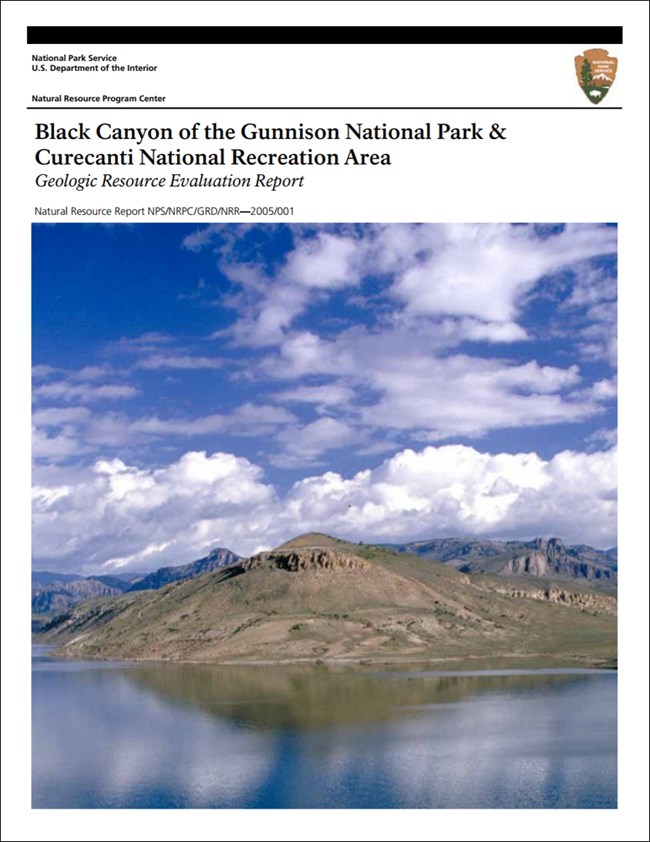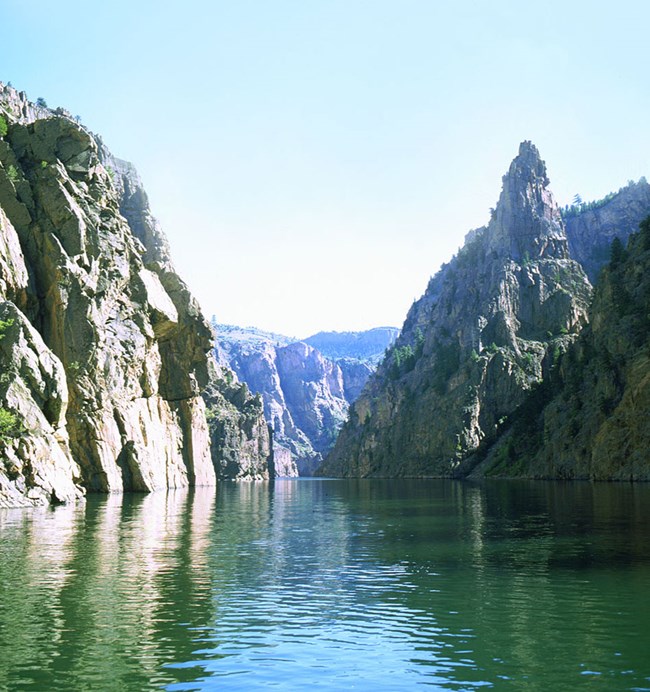Last updated: June 14, 2024
Article
NPS Geodiversity Atlas—Curecanti National Recreation Area, Colorado
Geodiversity refers to the full variety of natural geologic (rocks, minerals, sediments, fossils, landforms, and physical processes) and soil resources and processes that occur in the park. A product of the Geologic Resources Inventory, the NPS Geodiversity Atlas delivers information in support of education, Geoconservation, and integrated management of living (biotic) and non-living (abiotic) components of the ecosystem.

Introduction
Curecanti National Recreation Area (CURE) is located in west-central Colorado in Gunnison and Montrose Counties, between the southern Rocky Mountains to the east and the Colorado Plateau to the west. CURE was established February 11, 1965 with the completion of the Blue Mesa Dam, and encompasses 17,440 hectares (43,095 acres). The recreation area is a series of three reservoirs along the Gunnison River, known as Blue Mesa Lake, Morrow Point Lake, and Crystal Lake. Situated high in the Rocky Mountains, the sweeping mesas, deep canyons, and fjord-like lakes of CURE are a destination for water-based recreational enthusiasts. Popular activities include salmon and trout fishing, hiking boating, camping, and bird watching.
Geologic Setting
Rock layers exposed in CURE are like pages in a book, revealing the story of past environments and dynamic processes that took place many millions of years ago. The geologic surface in CURE and neighboring Black Canyon of the Gunnison National Park consist primarily of Precambrian, Jurassic, Cretaceous, and Paleogene-age rocks. These rocks record past environments that include ancient oceans, deserts, lakes, and rivers, and also contain dinosaur fossils. Over millions of years many geologic processes acted to carve the precipitous depths of the Black Canyon. The most obvious erosive forces today include the turbidity of the river carrying mud and debris, occasional rockfalls from high cliffs, and the relentless movement of landslides down into the canyon (Thornberry-Ehrlich 2005a). A notable geologic feature of CURE is the Curecanti Needle, located about 7.2 km (4.5 mi) downstream from Blue Mesa Dam near Sapinero, Colorado. This spire-like monolith rises nearly 244 m (800 ft) above the Gunnison River, and consists of Precambrian Curecanti Quartz Monzonite. The quartz monzonite (an intrusive igneous rock formed mostly of feldspar crystals, with a small amount of quartz) is an intrusive igneous unit that is part of the larger Berthoud Plutonic Suite and forms an irregularly shaped laccolith (sheet-like intrusion) centered around Curecanti Needle. CURE includes two stratotype occurrences: type localities for the Precambrian Curecanti Quartz Monzonite and Oligocene Dillon Mesa Tuff.
Geologic Formations
Through incredible erosion, the Gunnison River has exposed a wide range of rock types, from 1.7 billion year old gneiss and schist to Mesozoic – Cenozoic fossiliferous sedimentary rocks and modern unconsolidated sediments.
The steep, “black” walls of neighboring Black Canyon of the Gunnison are composed of Precambrian granites, gneisses, gabbros, diorites, pegmatites, and schists. The canyon itself is considered one of the best exposures of these ancient rocks in the world.
Directly atop the Precambrian rocks, lie Mesozoic and Cenozoic sedimentary strata. No Paleozoic sedimentary rocks exist in the Black Canyon – Curecanti area. The absence of Paleozoic strata creates an unconformity, indicating that approximately 370 million years of earth history are missing from this landscape. The Entrada Sandstone, Wanakah Formation, and Morrison Formation represent Jurassic time in the area. The fossils and depositional structures within these rocks record a vast array of Jurassic climates and environments.
Above the Jurassic rocks are the Cretaceous sandstones, shales, and coal beds of the Dakota Sandstone and Burro Canyon Formation. The muds of the Mancos Shale, the volcanic breccia of the Cimarron Ridge Formation, and the brown shales and calcareous sandstones of the Fruitland Formation and Pictured Cliffs Sandstone complete the Cretaceous strata at Black Canyon – Curecanti.
At the end of the Laramide orogeny volcanic activity erupted across the area resulting in large deposits of volcanic ash, tuff, and breccia. These and other Tertiary igneous rocks cap the regions mesas today. Specific formations include West Elk Breccia, Blue Mesa Tuff, Dillon Mesa Tuff, and Carpenter Ridge Tuff.
Today, Quaternary silts, sands, and gravels are preserved in the canyons and surface depressions of Black Canyon- Curecanti as terrace deposits, alluvium, and colluvium. They represent only a fraction of the deposits that once spread across this area, only to be subsequently stripped from the region by the relentless process of erosion.
Curecanti Needle
The Curecanti Needle is located about 7.2 km (4.5 mi) downstream from Blue Mesa Dam near Sapinero, Colorado. It is a spirelike monolith rising nearly 244 m (800 ft,) composed of an intrusive igneous rock called the Curecanti Quartz Monzonite. This name was applied by J. Fred Hunter in 1925. The quartz monzonite is Precambrian in age and forms an irregular, rather flat laccolith, roughly centered around Curecanti Needle. The laccolith is a pluton roughly 5.6 km (3.5 mi) across from west to east and 3.2 km (2 mi) from north to south (Hansen, 1964).
Dillon Pinnacles
The Dillon Pinnacles are comprised of West Elk Breccia. The West Elk Breccia contains solidified lava flows intermixed with coarse fragments of material resulting from the explosive destruction of previous volcanic features. The volume of the West Elk Breccia is enormous, remnants of the formation exceed 305 m (1000 ft) in thickness and conservative estimates of the formations original volume exceed 625 cubic km (150 cubic miles).
A popular hike in the park leads to the Dillon Pinnacles which typify the erosional formations contained within the West Elk Breccia. Cliffs, crags, pillars, windows and assorted erosional hoodoos abound.
Paleontological Resources
The fossil rich Morrison Formation is exposed within Black Canyon - Curecanti and dinosaur fossils continue to be found locally in this formation. Other units, such as the Mancos Shale and the Dakota Sandstone, also contain fossils that should be catalogued.
All NPS fossil resources are protected under the Paleontological Resources Preservation Act of 2009 (Public Law 111-11, Title VI, Subtitle D; 16 U.S.C. §§ 470aaa - 470aaa-11).
Regional Geology
Curecanti National Recreation Area is a part of the Southern Rocky Mountains Physiographic Province near it's indistinct boundary with the Colorado Plateaus Physiographic Province to the west, and the park shares its geologic history and some characteristic geologic formations with regions that extend well beyond park boundaries.
- Scoping summaries are records of scoping meetings where NPS staff and local geologists determined the park’s geologic mapping plan and what content should be included in the report.
- Digital geologic maps include files for viewing in GIS software, a guide to using the data, and a document with ancillary map information. Newer products also include data viewable in Google Earth and online map services.
- Reports use the maps to discuss the park’s setting and significance, notable geologic features and processes, geologic resource management issues, and geologic history.
- Posters are a static view of the GIS data in PDF format. Newer posters include aerial imagery or shaded relief and other park information. They are also included with the reports.
- Projects list basic information about the program and all products available for a park.
Source: NPS DataStore Saved Search 2800. To search for additional information, visit the NPS DataStore.
A NPS Soil Resources Inventory project has not been completed for Curecanti National Recreation Area. General information can be found on the NPS Data Store.
Source: NPS DataStore Saved Search 2834. To search for additional information, visit the NPS DataStore.

Related Links
Related Articles
Curecanti National Recreation Area
National Park Service Geodiversity Atlas
The servicewide Geodiversity Atlas provides information on geoheritage and geodiversity resources and values within the National Park System. This information supports science-based geoconservation and interpretation in the NPS, as well as STEM education in schools, museums, and field camps. The NPS Geologic Resources Division and many parks work with National and International geoconservation communities to ensure that NPS abiotic resources are managed using the highest standards and best practices available.
